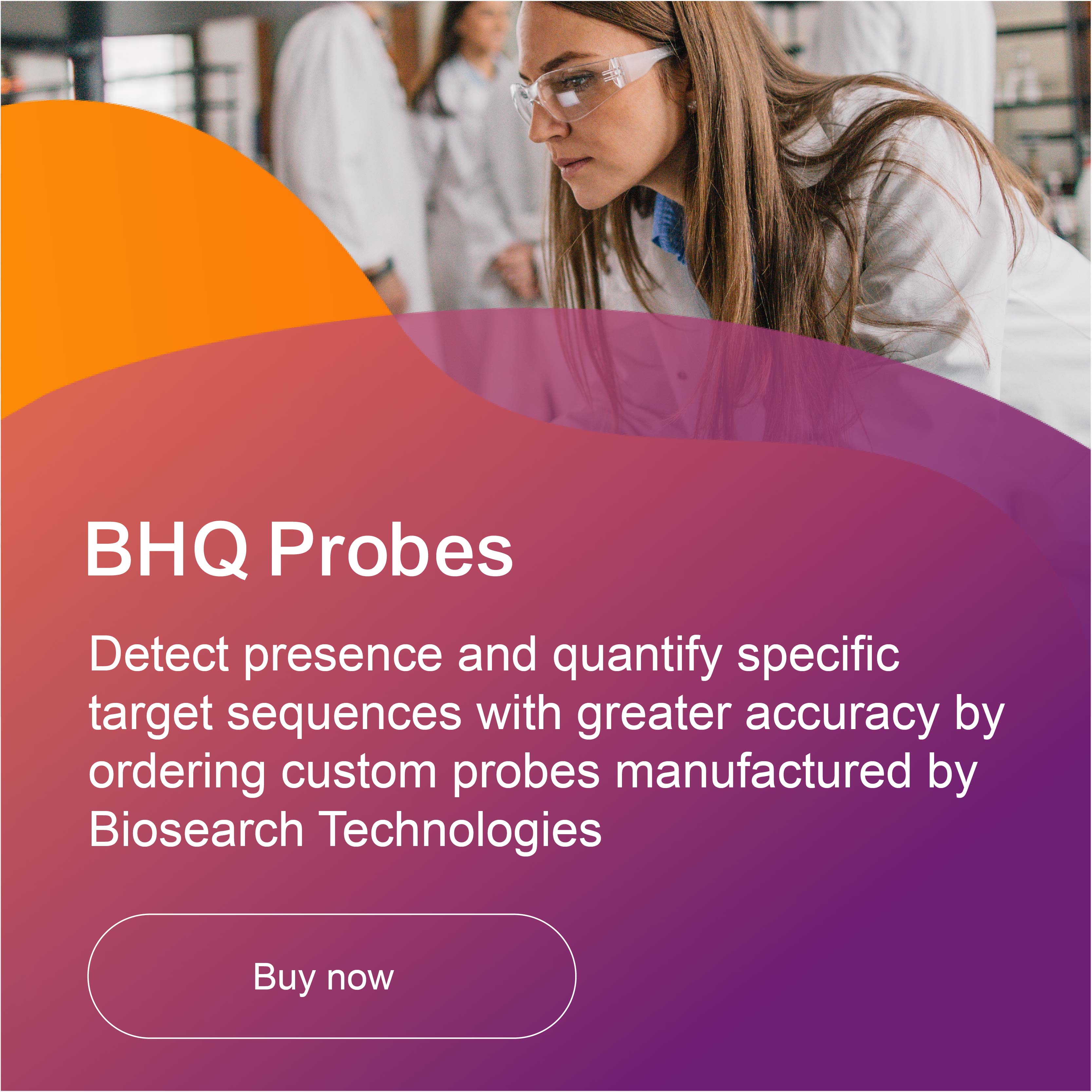Black Hole Quencher (BHQ) dyes
Black Hole Quencher (BHQ) dyes quench fluorescent signals with greater efficiency and specificity, improving data quality for new insights that enable you to accelerate your product development. There are two ways to buy BHQ dyes, either in CPG or amidite form so that you can make the probes yourself, or to order custom BHQ probes synthesised to your specification.
Superior performance. Unparalleled flexibility. For research and commercial use.
Having the right tools can make all the difference in your research. We created Black Hole Quencher™ (BHQ™) dyes over 20 years ago to help you get the most out of your experimental data, by offering superior performance and flexibility.

Explore the possibilities
LGC Biosearch Technologies is at the forefront of oligonucleotide synthesis, providing next-generation reagents that enable you to push the boundaries of scientific discovery. Designed to efficiently and effectively suppress background noise, you can obtain clearer data and more reliable results.
BHQ dyes are the only dark quencher dyes that enable you to synthesise your own oligos.
Researchers have the option to:
- Buy BHQ dyes directly (either CPG-bound, phosphoramidites or esters)
- Manufacture their own BHQ-labeled probes
- Buy BHQ probes synthesized by Biosearch Technologies
Key features of our BHQ dyes
- High signal-to-noise ratio
- Simplified design, implementation and interpretation of qPCR assays
- Integral to assays requiring single and multiplex gene expression
- High photostability, which means they can be used in a wider range of applications
- A full range of dyes spanning the entire visible spectrum to choose from, making it simple to find the right BHQ quencher for your project
Versatile dyes for every application
Research can be unpredictable. That's why we design our dyes to be adaptable, so that they can meet the changing needs of your experiment. Our BHQ dyes are highly versatile and robust quenchers, widely used in various applications:
- qPCR and real-time PCR
- SNP genotyping and end-point PCR
- Single and multiplex gene expression
- Copy number variation
- In vivo monitoring
Why choose Biosearch Technologies?
Our BHQ™ dyes have been the preferred quencher for qPCR probes and other fluorescence-quenched probe applications for over 20 years. And for good reasons:
- We’re the original inventor and manufacturer of Black Hole Quencher dyes, so we know them best. Generic products may look similar on the surface, but they don't offer the same level of quality or performance. Our Black Hole Quencher dyes have been tested and proven to give better results.
- Our BHQ dyes are the most widely used validated dark quenchers on the market with 10,000+ product citations.
- 6 out of 7 of WHO’s COVID-19 testing protocols use our BHQ dyes.
- Top 10 molecular diagnostic manufacturers leverage BHQ technology in their assays.
Your trusted supplier for BHQ dyes
We recognise how important it is to have a secure and reliable supply chain for critical components, which is why we produce our own BHQ dyes. You can trust us to supply the dyes you need, when and where you need them.
Resources and further reading
- Know your oligo mod: BHQTM (Black Hole QuencherTM) non-fluorescent quenchers
- Innovative applications for Black Hole Quencher dyes
- Labeling oligonucleotides with internal BHQ dyes
- Dual-labeled BHQ Probes- performance to "dye" for
- A way to simplify design and interpretation of your qPCR assays
- qPCR-based molecular diagnostics at the forefront of Zika surveillance
- Leveraging quenching efficiency of Black Hole Quencher dyes for PCR and beyond
- Nova is the new black
FAQs
Quenching is a mechanism used to absorb the fluorescence emitted by the reporter, until a change in their distance will produce a maximal change in detectable fluorescence and effectively signal the event being monitored (often hybridization or nuclease activity).
A quencher is a molecule that stops fluorescence from a fluorophore when excited by FRET (Förster Resonance Energy Transfer).
A reporter (such as FAM) and a quencher (such as BHQ-1 label) can join to create a new, non-fluorescent species known as an intramolecular dimer. The biomolecule linking the reporter and quencher acts as a tether and enables intramolecular association between the reporter and quencher.
The reporter and quencher are placed at specific sites in an oligonucleotide so that a change in their distance will produce a maximal change in detectable fluorescence, signalling the event being monitored (often hybridization or nuclease activity). The oligonucleotide acts as a flexible tether linking the fluorescent reporter and quencher.
Black Hole Quenchers (BHQ) are a family of dark quencher dyes with excellent spectral overlap with all common reporter dyes for efficient FRET quenching. BHQ labels have become the industry standard for quenchers in dual-labeled hydrolysis probes and many other molecular probe formats.
Black Hole Quencher dyes are true "dark" quenchers with no fluorescent signal, improving signal to noise ratios. Unlike other quenchers, they provide accurate results without any residual background signal through a combination of FRET and static quenching. Their complete quenching simplifies design, implementation and interpretation of qPCR assays.
BHQ dyes are true dark quenchers with no native emission due to their polyaromatic-azo backbone. Substituting electron-donating and withdrawing groups on the aromatic rings produces a complete series of quenchers with broad absorption curves that span the visible spectrum.
BHQ dyes work through a combination of FRET and static or contact quenching to enable researchers to avoid the residual background signal common to fluorescing quenchers such as TAMRA, or low signal to noise ratio. These quenchers can be paired with all common reporter dyes to construct efficiently quenched qPCR probes for multiplexing assays. In addition to quenching by FRET, BHQ dyes have also been shown to efficiently quench fluorescence through static or contact quenching via formation of an intramolecular ground state complex with the reporter dye.
TAMRA dye is an effective quencher for fluorophores with emission maxima less than 560 nm. Dyes with longer wavelength emissions will not be effectively quenched by TAMRA. In addition, TAMRA has its own fluorescence which complicates data analysis due to crosstalk between the channels. In contrast, Black Hole Quencher™ dyes are true "dark" quenchers with no fluorescent signal, therefore using them simplifies design, implementation and interpretation of qPCR assays.
Furthermore, Black Hole Quencher dyes have broad absorption spanning 480-580 nm (BHQ-1), 559-670 nm (BHQ-2) and 620-730 nm (BHQ-3), to enable use of a large range of spectrally distinct reporter dyes in multiplexed assay designs. With some dye pairings, FRET quenching is supplemented by the static quenching mechanism.
Specifically, hydrophobic and electrostatic interactions facilitate the association of BHQ dyes with certain reporters to form an intramolecular dimer, for enhanced quenching and improved signal to noise ratios. Thus, BHQ dyes may quench some fluorophores whose emission spectrum is beyond the limits of BHQ absorption.



